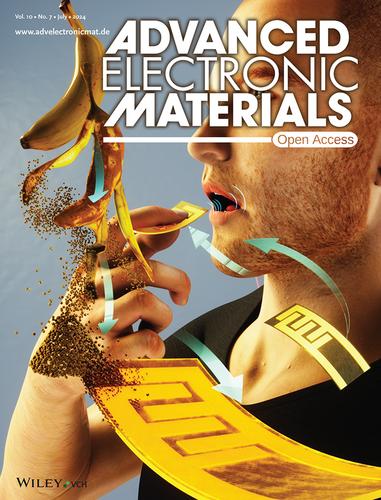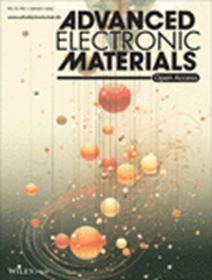Edible Electronic Components Made from Recycled Food Waste (Adv. Electron. Mater. 7/2024)
IF 5.3
2区 材料科学
Q2 MATERIALS SCIENCE, MULTIDISCIPLINARY
引用次数: 0
Abstract
From Food Waste to Electronic Components
This cover image illustrates the manufacturing process of functional electronic components from food residues, such as banana peel, for potential application in intraoral sensing. In article number 2300905, Goran M. Stojanovic with co-workers describes the procedure how to transform food waste, i.e. dried peels from lemon, orange, grapefruit, apple, banana, carrot, and potato, into powder for the creation of substrates for fabrication of capacitors and LC resonant circuits. This article contributes to the field of edible and biodegradable electronics.

利用回收厨余制造的可食用电子元件(Adv.)
从食物垃圾到电子元件这张封面图片展示了利用香蕉皮等食物残渣制造功能电子元件的过程,这种电子元件有望应用于口内传感技术。在编号为 2300905 的文章中,Goran M. Stojanovic 及其合作者介绍了如何将食物垃圾(即柠檬、橙子、柚子、苹果、香蕉、胡萝卜和马铃薯的干皮)转化为粉末,用于制作电容器和低电压谐振电路的基板。这篇文章为可食用和可生物降解电子学领域做出了贡献。
本文章由计算机程序翻译,如有差异,请以英文原文为准。
求助全文
约1分钟内获得全文
求助全文
来源期刊

Advanced Electronic Materials
NANOSCIENCE & NANOTECHNOLOGYMATERIALS SCIE-MATERIALS SCIENCE, MULTIDISCIPLINARY
CiteScore
11.00
自引率
3.20%
发文量
433
期刊介绍:
Advanced Electronic Materials is an interdisciplinary forum for peer-reviewed, high-quality, high-impact research in the fields of materials science, physics, and engineering of electronic and magnetic materials. It includes research on physics and physical properties of electronic and magnetic materials, spintronics, electronics, device physics and engineering, micro- and nano-electromechanical systems, and organic electronics, in addition to fundamental research.
文献相关原料
| 公司名称 | 产品信息 | 采购帮参考价格 |
|---|
 求助内容:
求助内容: 应助结果提醒方式:
应助结果提醒方式:


